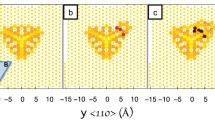Abstract
The continuum model for the growth of clusters developed in the previous paper (paper III) is applied to the formation of stacking fault tetrahedra in quenched gold and the formation of faulted vacancy loops in quenched aluminium. The results of the theory namely the distribution of the clusters as a function of their size and time, and the average size and the total density of the clusters as a function of time and the ageing temperature are shown to be in good agreement with the experimental results.
Similar content being viewed by others
References
Ananthakrishna G 1979aPramana 12 527
Ananthakrishna G 1979bPramana 12 543
Ananthakrishna G 1979cPramana 12 565
Jain K C and Siegel R W 1972Philos. Mag. 26 637
Kiritani M 1973J. Phys. Soc. Jpn. 35 95
McLachlan N W 1963Complex variable Theory and transform calculus (Cambridge: University Press) p. 105 and Chapter VIII
Author information
Authors and Affiliations
Rights and permissions
About this article
Cite this article
Ananthakrishna, G. A stochastic theory for clustering of quenched-in vacancies—IV. Continuum model applied to the formation of stacking fault tetrahedra and vacancy loops. Pramana - J. Phys 12, 581–591 (1979). https://doi.org/10.1007/BF02846851
Received:
Issue Date:
DOI: https://doi.org/10.1007/BF02846851




